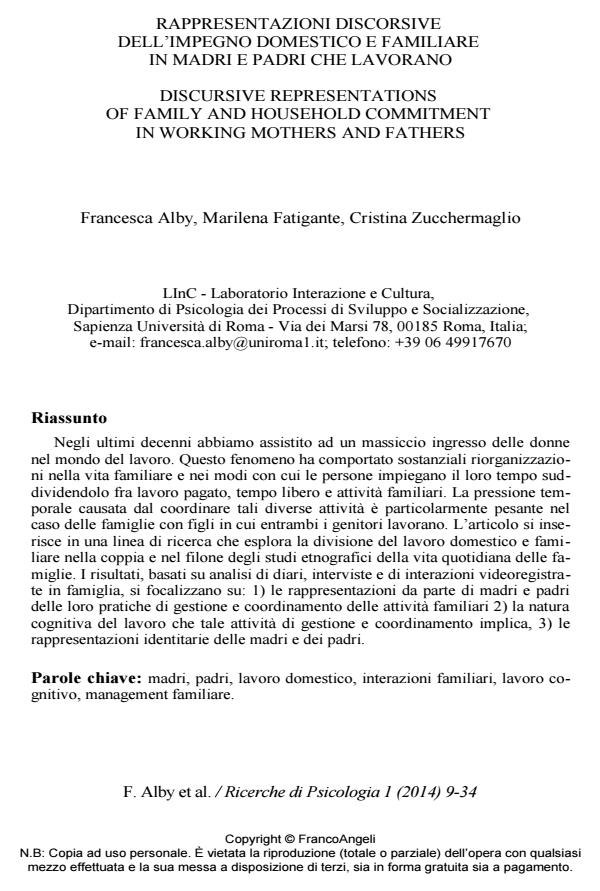Discursive representations of family and household commitment in working mothers and fathers
Journal title RICERCHE DI PSICOLOGIA
Author/s Francesca Alby, Marilena Fatigante, Cristina Zucchermaglio
Publishing Year 2014 Issue 2014/1
Language Italian Pages 26 P. 9-34 File size 268 KB
DOI 10.3280/RIP2014-001001
DOI is like a bar code for intellectual property: to have more infomation
click here
Below, you can see the article first page
If you want to buy this article in PDF format, you can do it, following the instructions to buy download credits

FrancoAngeli is member of Publishers International Linking Association, Inc (PILA), a not-for-profit association which run the CrossRef service enabling links to and from online scholarly content.
In recent decades we have witnessed a massive entry of women into the labor market. This phenomenon has resulted in substantial reorganization in family life and in the ways in which people spend their time dividing it between paid work, leisure and family activities. The temporal pressure caused by coordinating these various activities is particularly heavy in the case of families with children in which both parents work. The article is part of a line of research that explores the division of household labor in the couple within the tradition of ethnographic studies of everyday life of households. The findings, based on analysis of diaries, interviews and videotaped family interactions, focus on: 1) the representations on the part of mothers and fathers of their management practices and coordination of family activities 2) the nature of the cognitive work that such activity of management and coordination implies, 3) the identity representations of mothers and fathers.
Keywords: Mothers, fathers, housework, family interactions, cognitive work, family management
- The Caregiving Experiences of Fathers and Mothers of Children With Rare Diseases in Italy: Challenges and Social Support Perceptions Paola Cardinali, Laura Migliorini, Nadia Rania, in Frontiers in Psychology 1780/2019
DOI: 10.3389/fpsyg.2019.01780 - Daily Family Routines of Italian and Ecuadorian Immigrant Mothers in Everyday Life Nadia Rania, Laura Migliorini, Stefania Rebora, Paola Cardinali, in Sage Open 2158244015609411/2015
DOI: 10.1177/2158244015609411 - Parental Competence in Italy: A Comparison Between Italian and Immigrant Parents Nadia Rania, Laura Migliorini, Stefania Rebora, in Marriage & Family Review /2018 pp.1
DOI: 10.1080/01494929.2016.1247760 - Family well‐being during the COVID‐19 lockdown in Italy: Gender differences and solidarity networks of care Nadia Rania, Ilaria Coppola, Francesca Lagomarsino, Rosa Parisi, in Child & Family Social Work /2022 pp.1
DOI: 10.1111/cfs.12867
Francesca Alby, Marilena Fatigante, Cristina Zucchermaglio, Rappresentazioni discorsive dell’impegno domestico e familiare in madri e padri che lavorano in "RICERCHE DI PSICOLOGIA " 1/2014, pp 9-34, DOI: 10.3280/RIP2014-001001